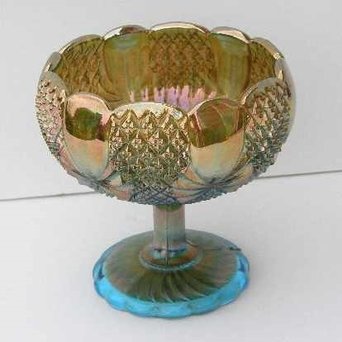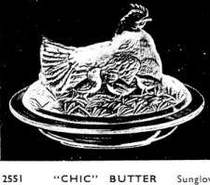Sowerby Blues
The real glories of Sowerby’s Carnival stem from the 1920s and full credit must be given to Percival Marson, the original Stourbridge developer of iridized glass.
The iridescent effects that they used were known as “Sunglow” (a golden iridescence like marigold found on clear base glass) and “Rainbo” (a deeper, darker effect usually found on amethyst, blue, blue/green, rare vaseline and black base glass).
Sowerby’s blue base glass varies tremendously from a consistent cobalt colouring to a variety of blue/green shades. Sowerby blue is truly delicious, and made all the more desirable by being so hard to find. Undoubtedly, the most often found Sowerby Carnival Glass colour is marigold. Amethyst is probably the next most often seen, though it certainly couldn’t be described as “easily found”. But blue (with some exceptions) is not easily found.
The iridescent effects that they used were known as “Sunglow” (a golden iridescence like marigold found on clear base glass) and “Rainbo” (a deeper, darker effect usually found on amethyst, blue, blue/green, rare vaseline and black base glass).
Sowerby’s blue base glass varies tremendously from a consistent cobalt colouring to a variety of blue/green shades. Sowerby blue is truly delicious, and made all the more desirable by being so hard to find. Undoubtedly, the most often found Sowerby Carnival Glass colour is marigold. Amethyst is probably the next most often seen, though it certainly couldn’t be described as “easily found”. But blue (with some exceptions) is not easily found.
|
Sowerby’s Wickerwork was their pattern number 1102, the moulds for which were made originally in the 1880s. The early, non-Carnival, examples often had the plate and stand stuck together while the later iridised versions were sold as two separate pieces. They were described in a 1927 Sowerby catalogue (below) as: “1102 Plate and Stand (Loose)". This was probably to ensure that the wholesalers who had previously handled the glued one-piece versions, now understood that it came as two separate pieces. |
Above: Sowerby’s Wickerwork in deep aqua blue.
Currently only one or two are reported in this colour. |
Arguably, this description was also to help optimise sales, as both items could be bought and used separately: the top being a plate, while the base was also marketed as a pin tray. The top half was made both as a cupped up bowl shape or as a flat plate. Sowerby’s Wickerwork stand often has the peacock head mark (in fact it sometimes has two!) while the plate frequently has no trademark. Both plate and stand are known in marigold. Amethyst is much harder to find and for many years only a few stands were reported, and only one or two examples of a blue Wickerwork plate are known currently. The open fretwork design means that these items are prone to damage, which probably contributes to their scarcity.
Arguably, this description was also to help optimise sales, as both items could be bought and used separately: the top being a plate, while the base was also marketed as a pin tray. The top half was made both as a cupped up bowl shape or as a flat plate. Sowerby’s Wickerwork stand often has the peacock head mark (in fact it sometimes has two!) while the plate frequently has no trademark. Both plate and stand are known in marigold. Amethyst is much harder to find and for many years only a few stands were reported, and only one or two examples of a blue Wickerwork plate are known currently. The open fretwork design means that these items are prone to damage, which probably contributes to their scarcity.
Above, left: the design of the plate is actually rather complex, almost mesmerising. The central picture shows an equally complex three-footed stand,
and on the right, the underside view of the plate which shows the delicate aqua colour of the glass.
and on the right, the underside view of the plate which shows the delicate aqua colour of the glass.
Sowerby’s Diving Dolphins bowl was their pattern number 1544. Diving Dolphins has a most unusual and decorative appeal, for the bowls stand on three feet, each being styled to form the shape of a dolphin’s head. The dolphin bodies curve sinuously up and onto the main part of the bowl. Around the sides of the bowl are stylised flowers and leaves, the combination of elements forming a most attractive, overall design.
The mould dates back to 1882, where it was shown in their "Pattern Book of Fancy Goods, lX, 1882" (below). As was the case with Wickerwork, Sowerby pulled the mould out of storage in the 1920s and re-used them to make Diving Dolphins bowls in Carnival Glass.
The mould dates back to 1882, where it was shown in their "Pattern Book of Fancy Goods, lX, 1882" (below). As was the case with Wickerwork, Sowerby pulled the mould out of storage in the 1920s and re-used them to make Diving Dolphins bowls in Carnival Glass.
|
Sowerby clearly thought the the original plain interior of the Diving Dolphins needed to be more "eye-catching", and their Carnival versions used a variation of the Scroll Embossed pattern that they copied from Imperial.
We have a full Collectors Facts on Diving Dolphins, including the connection to a fountain built in honour of Queen Victoria!
|
The ever-popular Daisy Block Rowboat is aother old mould that Sowerby revived to make Carnival Glass. It was their pattern number 1874, and it was shown in Sowerby's 1885 catalogue (right). In the early (pre-Carnival) days, it was made in three sizes, as shown, with a one size of stand to fit all of them. Only the 12 inch boat was made in Carnival Glass - in marigold, amethyst and aqua. To date, no Carnival Glass stand has been discovered in any colour.
Sowerby's Pineapple pattern was their "Service 2349" pattern, introduced in pre-Carnival shapes and colours in around 1912. Several of the shapes were subsequently made in Carnival from the 1920s.
|
Below and right are two pictures, courtesy of Ellen Richardson, of her Pineapple stemmed sugar in rich aqua blue base glass. It has a very unusual cupped-in (rose bowl top) shape of this piece, and it has the Sowerby peacock head trademark in the centre of the base. |
Below on the left, is an extract from the (pre-Carnival) 1912 Sowerby catalogue. In the centre is a seldom seen blue Pineapple creamer (the strong iridescence makes it look amethyst), and a blue Pineapple sugar that has flared out sides, the sugar bowl shape that is seen more frequently.
|
Sowerby's Derby (also known as Pinwheel) was another of their major pattern suites - Sowerby's "Service No. 2414".
The vases were made in three heights: 6½, 8 and 10½ inches, and they have a domed base. It is an intaglio geometric pattern, the dominant feature being an eight pointed star. Of particular interest is the fact that an almost identical pattern was produced by Josef Inwald of Czechoslovakia (albeit in different heights). Derby vases in Carnival are generally rather scarce in any size. The name Derby was given to this range by Sowerby during the early 1930s; prior to that it had simply been known by its pattern (service) number, 2414. Currently, there are very few examples known in blue, and only in the 8 inch size. |
An 8 inch Derby vase, one of
very few known in blue. |
|
Sowerby's beautiful Flora bowl is their pattern number 2565. It is an exterior pattern of roses and leaves, found on a 9 - 10 inch bowl. Very unusually it is an exterior intaglio pattern, with a ground base, being made from a one piece mould and "stuck-up".
|
Covered Hen (2551) and Covered Swan (2031) - two iconic covered butters made by Sowerby.
|
The Covered Hen is a fascinating item, first seen in the Sowerby catalogues in 1928 with the pattern number 2551, when it was called the “Chic butter.” A similar item, registered in 1889, was made by Matthew Turnbull of Sunderland, and it’s quite possible that Sowerby acquired this mould or simply copied it.
Some Sowerby examples have been seen with a Sowerby paper label. The lid is a hen surrounded by her family of chicks: there are variations with regard to the little chicks and the rocks that surround the hen. It is known in marigold and in blue. |
|
The Covered Swan is Sowerby's pattern number 2031, and like some of the Carnival items referred to above, it was made in the 1920s, using a mould that was originally from the early 1880s. It is a masterpiece, a breathtakingly beautiful item that makes one marvel at the skills of the mouldmakers and glassmakers.
|
This design, which has the open spaces between the head, neck and body of the swan, was listed in the 1927 catalogue as being made in Sunglow (marigold) and Rainbo lustre (amethyst). There is no mention of blue, and to date, no blue Covered Swans have been found with this open neck design.
|
However, there is another, newer version of Sowerby's Covered Swan, which is shown on the right. It is similar in overall concept to the older version detailed above, but the design has many differences. Most noticeable is that the two spaces between head, neck and body are filled in with glass. Additionally, the edge to the base is smooth, not scalloped and the lid fits over the outside of the raised rim on the base, not the inside as in the older version. Overall, it sits a little taller than the older design and in fact its base is identical to that on the Covered Hen. It is not possible to be certain when these items were made. They are known in blue and (rarer) marigold. |
Chunky, aka Sowerby 2266, aka English Hob and Button.
Although Chunky is known primarily in marigold, in a range of different shapes, rare example of a 10 inch bowl in cobalt blue have been reported. Unusually, they also have a marie (collar base) which appears to have been ground. We have much more information about Chunky (and the way to avoid confusion with the Indiana Hostess "look-alike" pattern, here: Collectors Facts: Chunky.
Although Chunky is known primarily in marigold, in a range of different shapes, rare example of a 10 inch bowl in cobalt blue have been reported. Unusually, they also have a marie (collar base) which appears to have been ground. We have much more information about Chunky (and the way to avoid confusion with the Indiana Hostess "look-alike" pattern, here: Collectors Facts: Chunky.
























